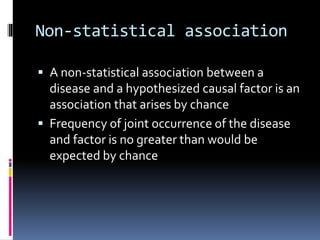Associations[1]
- 1. PROF. DR. MANSUR-UD-DIN AHMAD Associations(Chap3)
- 2. Variables ï§ A variable is any observable event that can vary: ïš Examples: ïš Weight ïš Age of an animal ïš Number of cases of disease
- 3. Study variable ï§ A study variable is any variable that is being considered in an investigation
- 4. Response and explanatory variables ï§ A response variable is one that is affected by another (explanatory) variable ï§ Example: ï§ Effects of dry cat food on the occurrence of urolithiasis, cat food is the explanatory variable and urolithiasis is the response variable
- 5. Types of association ï§ Association is the degree of dependence or independence between two variables. ï§ Main types of association 1. Non-statistical association; 2. Statistical association
- 7. Types of association between disease and hypothesized causal factors. ï§ (1) Statistically unassociated ï§ (2) Statistically associated Causally associated Non·causally associated
- 9. Non-statistical association ï§ A non-statistical association between a disease and a hypothesized causal factor is an association that arises by chance ï§ Frequency of joint occurrence of the disease and factor is no greater than would be expected by chance
- 10. Example ï§ Mycoplasma felis has been isolated from the eyes of some cats with conjunctivitis. ï§ This represents an association between the Mycoplasma and conjunctivitis in these cats
- 11. ï§ Surveys have shown that M. felis also can be recovered from the conjunctivae of 80% of apparently normal ï§ Analysis: ïš Association between conjunctivitis and the presence of M. felis arose by chance
- 12. Statistical association ï§ Variables are positively statistically associated when they occur together more frequently than would be expected by chance ï§ Negatively statistically associated when they occur together less frequently than would be expected by chance.
- 13. Path diagrams ï§ Indicating the paradigm ï§ (a) an example ï§ (b) of causal and non-causal statistical associations. ï§ A = Cause of disease (explanatory variable); B and C = manifestations of disease ï§ (response variables) causal association; non-causal association.
- 14. B ï§ A C Infection with haemonchus contortus Abomasal mucosal hyperplasia Anaemia
- 15. Infection of cattle with Haemonchus contortus ï§ If infection of cattle with Haemonchus contortus were being investigated, then the following positive statistical associations could be found: ïš Between the presence of the parasite and Abomasal mucosal hyperplasia; ïš Between the presence of the parasite and anaemia; ïš BetweenAbomasal mucosal hyperplasia and anaemia.
- 16. ï§ The first two associations are causal and the third non-causal ï§ Abomasal mucosal hyperplasia and infection with H. contortus are risk factors for anaemia, that is, their presence increases the risk of anaemia
- 17. Confounding ï§ Confounding (Latin: confundere = to mix together) is the effect of an extraneous variable that can wholly or partly account for an apparent association between variables
- 18. Confounder ï§ A variable that confounds is called a confounding variable or confounder ï§ A confounding variable is distributed non- randomly (i.e., positively or negatively correlated with the explanatory and response variables that are being studied)
- 19. ï§ A confounding variable generally must: ïš Be a risk factor for the disease that is being studied; ïš Be associated with the explanatory variable, but not be a consequence of exposure to it.
- 20. The association between coffee drinking and pancreatic cancer
- 21. Schematic representation of the issue of potential confounding
- 22. Causal models ï§ The associations and interactions between direct and indirect causes can be viewed in two ways, producing two causal 'models
- 23. Causal model 1 ï§ The relationship of causes to their effects allows classification of causes into two types: ï§ Sufficient ï§ Necessary
- 24. Sufficient cause ï§ A cause is sufficient if it inevitably produces an effect (assuming that nothing happens that interrupts the development of the effect, such as death or prophylaxis). ï§ A sufficient cause virtually always comprises a range of component causes; disease therefore is multifactorial.
- 25. Example ï§ Distemper virus-cause of distemper, although the sufficient cause actually involves ï§ Exposure to the virus ï§ Lack of immunity ï§ Other components.
- 26. ï§ It is not necessary to identify all components of a sufficient cause to prevent disease because removal of one component may render the cause insufficient
- 27. necessary cause ï§ If a cause is a component of every sufficient cause, then it is necessary ï§ A necessary cause must always be present to produce an effect
- 28. Example ïš Cause that is necessary but not sufficient is infection with Actinobacillus ligneresi, which must occur before actinobacillosis ('wooden tongue') can develop
- 29. Component causes therefore include factors that have been classified as ï§ Predisposing factors: ïš Which increase the level of susceptibility in the host (e.g., age and immune status) ï§ Enabling factors: ïš Which facilitate manifestation of a disease (e.g., housing and nutrition)
- 30. ï§ Precipitating factors: ïš which are associated with the definitive onset of disease (e.g., many toxic and infectious agents) ï§ Reinforcing factors: ïš Which tend to aggravate the presence of a disease (e.g., repeated exposure to an infectious agent in the absence of an immune response).
- 31. example ï§ Pneumonia is a disease that has sufficient causes, none of which has a necessary component. ï§ Pneumonia may have been produced in one case by heat stress where a dry, dusty environment allowed microscopic particulate matter to reach the alveoli. ï§ Cold stress could produce a clinically similar result
- 32. Formulating a causal hypothesis ï§ First step in any epidemiological investigation of cause is descriptive. ï§ A description of time, place, and population is useful initially.
- 33. Time ï§ Associations with year, season, month, day, or even hour in the case of food poisoning investigations, should be considered. ï§ Information on climatic influences, incubation periods and sources of infection
- 34. example ï§ An outbreak of Salmonellosis in a group of cattle may be associated with the introduction of infected cattle feed
- 35. Place ï§ The geographical distribution of a disease may indicate an association with local geological, management or ecological factors ï§ Epidemiological maps are a valuable aid to identifying geographical associations
- 36. Population ï§ The type of animal that is affected often is of considerable importance. ï§ Hereford cattle are more susceptible to squamous cell carcinoma of the eye than other breeds, suggesting that the cause may be partly genetic
- 37. ï§ An epidemiological investigation is similar to any detective novel that unfolds a list of 'suspects' (possible causal factors), some of which may be non-statistically associated with a disease, and some statistically associated with the disease, either causally or non-causally.
- 38. Principles for establishing cause: Hill's criteria ï§ The British medical statistician, Austin Bradford Hill, proposed several criteria for establishing a causal association including ïš The time sequence of the events ïš The strength of the association ïš Biological gradient ïš Consistency ïš Compatibility with existing knowledge
- 39. Time sequence ï§ Cause must precede effect ï§ Unless bacterial infections were present before the mares became infertile (incorrect to infer the bacterial infections)
- 40. Strength of association ï§ If a factor is causal, then there will be a strong positive statistical association between the factor and the disease.
- 41. Biological gradient ï§ If a dose-response relationship can be found between a factor and a disease, the plausibility of a factor being causal is increased. ï§ This is the basis of reasoning by the method of concomitant variation
- 42. Examples ï§ Frequency of milking in relation to Leptospirosis ï§ Smoking in relation to lung cancer
- 43. Consistency ï§ If an association exists in a number of different circumstances, then a causal relationship is probable. ï§ This is the basis of reasoning by the method of agreement. ï§ An example is bovine hyperkeratosis
- 44. Example; Bovine hyperkeratosis ï§ The disease was called 'X disease' because initially the cause was unknown. It occurred in different circumstances: ïš in cattle that were fed sliced bread; ïš in calves that had been licking lubricating oil; ïš in cattle that were in contact with wood preservative. ï§ The bread slicing machine was lubricated with a similar oil to that which had been licked by the calves.The lubricating oil and the wood preservative both contained chlorinated naphthalene.This chemical was common to the different circumstances and subsequently was shown to cause hyperkeratosis
- 45. Compatibility with existing knowledge ï§ It is more reasonable to infer that a factor causes a disease if a plausible biological mechanism has been identified than if such a mechanism is not known
- 46. Example ï§ Smoking can be suggested as a likely cause of lung cancer because other chemical and environmental pollutants are known to have a carcinogenic effect on laboratory animals
- 47. THANKS














































